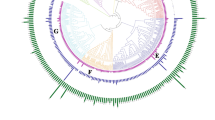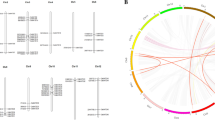Abstract
The multidrug and toxic compound extrusion (MATE) protein family is a newly discovered family of secondary transporters that extrude metabolic waste and a variety of antibiotics out of the cell using an electrochemical gradient of H+ or Na+ across the membrane. The main function of MATE gene family is to participate in the process of plant detoxification and morphogenesis. The genome-wide analysis of the MATE genes in potato genome was conducted. At least 48 genes were initially identified and classified into six subfamilies. The chromosomal localization of MATE gene family showed that they could be distributed on 11 chromosomes except chromosome 9. The number of amino acids is 145–616, the molecular weight of proteins is 15.96–66.13 KD, the isoelectric point is 4.97–9.17, and they were located on the endoplasmic reticulum with having 4–13 transmembrane segments. They contain only two parts of the exons and UTR without introns. Some members of the first subfamily of potato MATE gene family are clustered with At2g04070 and they may be related to the transport of toxic compounds such as alkaloids and heavy metal. The function of the members of the second subfamily may be similar to that of At3g23560, which is related to tetramethylammonium transport. Some members of the third subfamily are clustered with At3g59030 and they may be involved in the transport of flavonoids. The fifth subfamily may be related to the transport of iron ions. The function of the sixth subfamily may be similar to that of At4g39030, which is related to salicylic acid transport. There are three kinds of conserved motifs in potato MATE genes, including the motif 1, motif 2, and motif 3. Each motif has 50 amino acids. The number of each motif is different in the gene sequence, of which 45 MATE genes contain at least a motif, but there is no motif in ST0015301, ST0045283, and ST0082336. These results provide a reference for further research on the function of potato MATE genes.




Similar content being viewed by others
References
Li J, Xie C (2016) Production technology and management measures of forestry seedling. Modern Hort 2(23):82. (in Chinese)
Guo X (2016) Genome-wide identification and analysis of ALDH and MATE gene families in Gossypium. Chinese Academy of Agricultrual Sciences, Beijing. (in Chinese)
Dai LY, Liu XL, Xiao YH, Wang GL (2007) Recent advances in cloning and characterization of disease resistance genes in rice. J Integr Plant Biol 49(1):112–119
Liu G, Sanchez-Fernandez R, Li ZS, Rea PA (2001) Enhanced multi-specificity of Arabidopsis vacuolar multidrug resistance associated protein type ATP binding cassette transporter, AtMRP2. J Biol Chem 276(12):8648–8656
Zgurskaya HI, Nikaido H (2000) Multidrug resistance mechanisms: drug efflux across two membranes. Mol Microbiol 37(2):219–225
Dixon DP, Cummins L, Cole DJ, Edwards R (1998) Glutathione mediated detoxification systems in plants. Curr Opin Plant Biol 1(3):258–266
Putman M, Vn Veen HW, Koninus WN (2000) Molecular properties of bacterial multidrug transporters. Microbial Mol Biol Rev 64(4):672–693
Remy E, Duque P (2014) Beyond cellular detoxification: a plethora of physiological roles for MDR transporter homologs in plants. Front Physiol 5:201
Brown MH, Paulsen IT, Skurray RA (1999) The multidrug efflux protein NorM is a prototype of a new family of transporters. Mol Microbiol 31(1):394–395
Dimroth P (1997) Primary sodium ion translocating enzymes. Biochim Biophys Acta 1318(1–2):11–51
Maloney PC (1992) The molecular and cell biology of anion transport by bacteria. Bio Essays 14(11):757–762
Chen S, Sánchez-Fernández R, Lyver ER, Dancis A, Rea PA (2007) Functional characterization of AtATM1, At ATM2 and AtATM3, a subfamily of Arabidopsis half-molecule ATP-binding cassette transporters implicated in iron homeostasis. J Biol Chem 282(29):21561–21571
Zhao H, Li Y (2012) ABC transporters in plants. Hai Xia Ke Xue 2:13–16 (in Chinese)
Leng F, Wei Q, Wang Y, Jing Y, Sun S, Ma H, Wang Y, Ma J (2017) Cloning and bioinformatics analysing of RND transporters family (rnd-1) in Acidithiobacillus ferrooxidans. Genom App Biol 36(6):2410–2416. (in Chinese)
Bay DC, Turner RJ (2009) Diversity and evolution of the small multidrug resistance protein family. BMC Evol Biol 9:140
Schuldiner S. Emr E (2009) A model for studying evolution and mechanism of ion-coupled transporters. Biochim Biophys Acta 1794(5):748–762
Saier MH (1999) Genome archeology leading to the characterization and classification of transport proteins. Curr Opin Microbiol 2(5):555–561
Saier MH Jr, Yen MR, Noto K, Tamang DG, Elkan C (2009) The transporter classification database: recent advances. Nucleic Acids Res 37(Database issue):D274–D278
Morita Y, Kodama K, Shiota S, Mine T, Kataoka A, Mizushima T, Tsuchiya T (1998) NorM, a putative multidrug efflux protein, of vibrio parahaemolyticus and its homolog in Escherichia coli. Antimicrob Agents Chemother 42(7):1778–1782
Morita Y, Kataoka A, Shiota S, Mizushima T, Tsuchiya T (2000) NorM of vibrio parahaemolyticus is an Na(+)-driven multidrugefflux pump. J Bacteriol 182(23):6694–6697
Pao SS, Paulsen IT, Saier MH Jr (1998) Major facilitator superfamily. Microbiol Mol Biol Rev 62(1):1–34
Chung YJ, Krueger C, Metzgar D, Saier MH Jr (2001) Size comparisons amongintegral membrane transport protein homologues in bacteria, ar-chaea, and eucarya. J Bacteriol 183(3):1012–1021
Diener AC, Gaxiola RA, Fink GR (2001) Arabidopsis ALF5, a mul-tidrug efflux transporter gene family member, confers resistance to toxins. Plant Cell 13(7):1625–1638
Debeaujon I, Peeters AJ, Leon-Kloosterziel KM, Koornneef M (2001) The TRANSPARENT TESTA12 gene of Arabidopsis encodesa multidrug secondary transporter-like protein required for flavonoid sequestration in vacuoles of the seed coat endothelium. Plant Cell 13(4):853–871
Maualhaes JV (2010) How a microbial drug transporter became essential for crop cultivation on acid soils: aluminium tolerance conferred by the multidrug and toxic compound extrusion (MATE) family. Ann Bot 106(1):199–203
Moriyama Y, Hiasa M, Matstimoto T, Omote H (2008) Multi-drug and toxic compound extrusion (MATF)-type proteins as anchor transporters for the excretion of metabolic waste products and xenobiotics. Xenobiotica 38(7–8):1107–1118
Yu S, Wei L, Xie H, Zhang J (2014) Progress on MATE transporters of stress resistance in rice. Fujian J Agric Sci 9(4):398–405. (in Chinese)
Lu M, Radchenko M, Symersky J, Nie R, Guo Y (2013) Structural insights into H+-coupled multidrug extrusion by a MATE transporter. Nat Struct Mol Biol 20(11):1310–1317
Otsuka M, Matsumoto T, Morimoto R, Arioka S, Omote H, Moriyama Y (2005) Ahuman transporter protein that mediates the final excretion step for toxic organic canons. Proc Natl Acad Sci USA 102(50):17923–17928
Shiomi N, Fukuda H, Fukuda Y, Murata K, Kimura A (1991) Nucleotide sequence and characterization of a Gene conferring resistance to ethionine in yeast Saccharomyces cerevisiae. J Ferment Bioeng 71(4):211–215
Omote H (2006) The MATE proteins as fundamental transporters of metabolic and xenobiotic organic cations. Trends Pharmacol Sci 27(11):587–593
Li L, He Z, Pandey GK, Tsuchiya T, Luan S (2002) Functional cloning and characterization of a plant efflux carrier for multidrugand heavy metal detoxification. J Biol Chem 277(7):5360–5368
Xie X, Cheng T, Wang G, Duan J, Xia Q (2011) ABC and MATE transporters of plant and their roles in membrane transport of secondary metabolites. Plant Physiol J 47(8):752–758. (in Chinese)
Rogers EE, Guerinot ML (2002) FRD3, a member of the multidrugand toxin efflux family, controls iron deficiency responses in Arabidopsis. Plant Cell 14(8):1787–1799
Yokosho K, Yamaji N, Ueno D, Mitani N, Ma JF (2009) OsFRDL1 is a citrate transporter required for efficient translocation of iron in rice. Plant Physiol 149(1):297–305
Zhang J, Xu H, Zhou X, Chen J, Wang Y, Peng X (2010) Expression analysis of OsMATE in rice under abiotic stresses. J Trop Subtrop Bot 18(4):435–439. (in Chinese)
Tiwari M, Sharma D, Singh M, Tripathi RD, Trivedi PK (2014) Expression of OsMATE1 and OsMATE2 alters development, stress responses and pathogen susceptibility in Arabidopsis. Sci Rep 4:1–12
Zhang T, Zhang S, Pei L, Yu T, Chen M, Li L, Zhou Y, Ma Y, Xu Q, Xu Z (2014) Genome-wide analysis of ANK gene family and expression pattern of the ANK25 gene in snap bean. J Plant Genet Resour 5(6):1340–1348. (in Chinese)
Nawrath C, Heck S, Parinthawong N, Metraux JP (2002) EDS5, anessential component of salicylic acid-dependent signaling for disease resistance in Arabidopsis, is a member of the MATE transporter family. Plant Cell 14(1):275–286
Li R, Li J, Li S, Qin G, Novak O, Pencik A, Ljung K, Aoyama T, Liu J, Murphy A, Gu H, Tsuge T, Qu LJ (2014) ADPI affects plant architecture by regulating local auxin biosynthesis. PLoS Genet 10(1):e1003954
Zhang Y, Wang Q, Li X, Sun T, Gong D, Yang M, Liu G (2015) Analysis and functional prediction of MATE gene family in common tobacco (Nicotiana tabacum). J Plant Genet Resour 16(6):1307–1314. (in Chinese)
Shen Z, Xu L, Chen W, Wu N, Cai Y, Lin Y, Gao J (2016) Bioinformatic analysis of the multidrug and toxic compound extrusion gene family in Gossypium arboreum and Gossypium raimondii, and expression of orthologs in Gossypium hirsutum. Cotton Sci 28(3):215–226. (in Chinese)
Zhao J, Dixon RA (2009) MATE transporters facilitate vacuolar uptake of epicatechin 3′-O-glucoside for proanthocyanidin biosynthesis in Medicago truncatula and Arabidopsis. Plant Cell 21(8):2323–2340
Marinova K, Pource L, Weder B, Schwarz M, Barron D, Routaboul JM, Debeaujon I, Klein M (2007) The Arabidopsis MATE transporter TT12 acts as a vacuolar flavonoid/H+-antiporter active in proanthocyanidin-accumulating cells of the seed coat. Plant Cell 19(6):2023–2038
Serrano M, Wang B, Aryal B, Garcion C, Abou-Mansour E, Heck S, Geisler M, Mauch F, Nawrath C, Metraux JP (2013) Export of salicylic acid from the chloroplast requires the multidrug and toxin extrusion-like transporter EDS5. Plant Physiol 162(4):1815–1821
Acknowledgements
This study was supported by grants from the National Natural Science Foundation of China (Grant Nos. 31660352, 31660350) and the Science & Technology Development Fund of Guangxi Academy of Agricultural Sciences (Grant Nos. Guinongke2017JZ11 and Guinongke2017JZ21).
Author information
Authors and Affiliations
Corresponding authors
Ethics declarations
Conflict of interest
The authors declare that they have no conflict of interest.
Rights and permissions
About this article
Cite this article
Li, Y., He, H. & He, LF. Genome-wide analysis of the MATE gene family in potato. Mol Biol Rep 46, 403–414 (2019). https://doi.org/10.1007/s11033-018-4487-y
Received:
Accepted:
Published:
Issue Date:
DOI: https://doi.org/10.1007/s11033-018-4487-y




